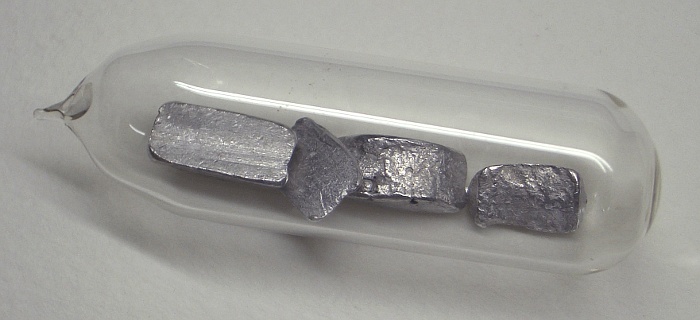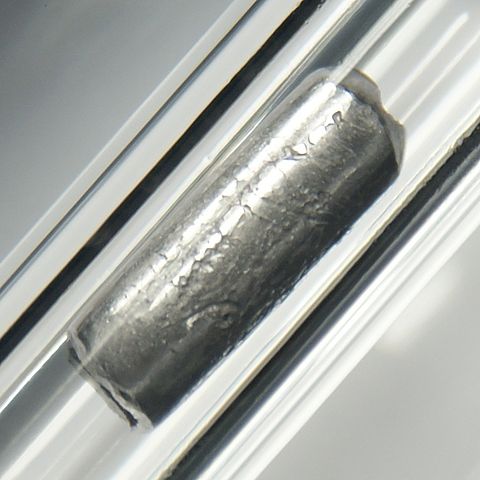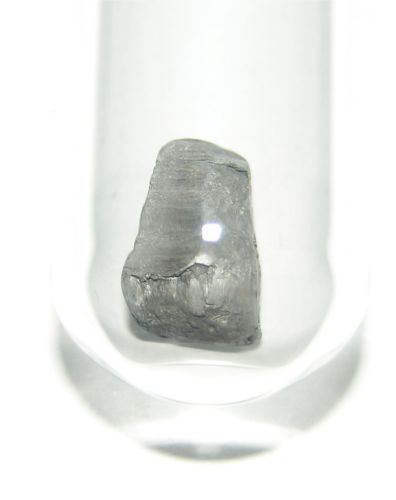Thallium is a chemical element with the symbol Tl and atomic number 81. It is a soft, bluish-white metal and is one of the least abundant elements on Earth. It was discovered in 1861 by British chemist William Crookes and named after the Greek word for “green twig”.
Thallium is one of the oldest known elements and has been used in a variety of applications throughout history.
Introduction
Thallium has some unique characteristics that make it stand out among other elements. It is highly reactive and can corrode many materials, including metals, plastics, and glass. As a result, it has found some niche uses, such as in thermometers, switches, and television tubes. Additionally, it is also used as a poison, and in the past was deliberately used to harm and even kill people.
The majority of thallium on the earth is found in the earth’s crust, in minerals such as iron pyrites, litharge, and thallite. It can also be found in the waters of oceans and other bodies of water. The majority of thallium produced today is from the processing of copper, lead, and zinc ores. Thallium can also be produced synthetically, though this is not widely practiced today.
Thallium has several physical properties that make it unique among elements. It is a soft and malleable metal, with a melting point of 303.5°C and boiling point of 1473°C. Thallium is also highly reactive and can form a variety of compounds with other elements, such as oxygen, sulfur, and chlorine. It is also a poor conductor of electricity.

Because of its reactivity, thallium has a variety of chemical properties. It can form several different compounds, including thallium(I) oxide, thallium(III) chloride, and thallium sulfate.
It can also form polymeric compounds, which are compounds that contain atoms of both thallium and other elements. Additionally, thallium has a nuclear property, which is the ability to be subjected to nuclear reactions, such as fission and fusion.
Thallium can be found in various forms, such as the metal itself, a sulfate salt, and an oxide. Its industrial uses are wide ranging, from the production of semiconductor materials to the manufacture of photographic chemicals. It also has some medical uses, such as in the treatment of cancer and as a tracer in medical imaging.
Thallium can be harmful, especially when it is ingested or inhaled. Its primary toxic effects are neurological, causing numbness, confusion, and even death in extreme cases. Therefore, it is important to take precautions when handling thallium and its compounds.
Overall, thallium is an element with some unique and valuable characteristics. Despite its potential risks, it has been used in a variety of applications throughout history and continues to be a key element in modern industry and science. This guide will provide an overview of thallium, its properties, sources, biological role, detection methods, and applications.
Properties of Thallium
Thallium is a chemical element with the symbol Tl and atomic number 81. It is a soft, bluish-white metal with a metallic luster that tarnishes in the air and is found in nature in trace amounts, usually in ores. Thallium is a member of the post-transition metal group and its properties make it a valuable component in a wide variety of applications.
Understanding the physical and chemical properties of thallium is important to know how it interacts with other elements and materials. Some of these properties include atomic weight, melting point, and boiling point.
Atomic Weight: Thallium has an atomic weight of 204.38 g/mol and is the third-lightest element in the periodic table. Its atomic weight is the sum of the number of protons and neutrons in an atom of thallium.
Melting Point: Thallium has a melting point of 303.5°C (577.9°F), which is higher than that of most metals. It is the only metal that is liquid at room temperature, though at higher temperatures it becomes a solid.
Boiling Point: Thallium also has a boiling point of 1473°C (2703°F). It is one of the few elements that have a higher boiling point than its melting point.
Chemical Properties: Thallium has two common oxidation states, +3 and +1. It has an affinity for sulfur, making it reactive with many elements, especially sulfur-containing compounds. It also has a tendency to form compounds with a variety of elements, including carbon, nitrogen, and oxygen.
Nuclear Properties: Thallium has a half-life of 3.78 days and is used in nuclear medical imaging. It is also used in nuclear power plants as a neutron absorber.
When exposed to air, thallium tarnishes quickly, forming a thin layer of corrosion on the surface of the metal. This layer of tarnish can be removed with a mild acid solution. Thallium is also highly toxic, so special precautions must be taken when handling it.
Thallium is a valuable component in a wide variety of applications, from electrical cables and semiconductors to medical imaging and nuclear power. Understanding the physical and chemical properties of thallium is essential to using it safely and effectively. By understanding its properties, we can ensure the safe handling, use, and disposal of this element.
Location and Sources
Thallium is a chemical element that has a wide variety of sources and forms and is found naturally in the environment. It is a soft, malleable, and bluish-white metal that is found in trace amounts in some rocks and soils. It can also be found in small amounts in some foods, as well as in industrial products such as pesticides, dyes, and photographic emulsions.
When it comes to the sources of thallium, it is primarily found in trace amounts in minerals such as crooksite, lorandite, and hutchinsonite. It is also found in sulfide ores, including copper, lead, zinc, and iron sulfide ores. In addition, it can be found as a by-product in the production of zinc, lead, and other metals.
Thallium exists in a variety of forms, such as thallium sulfide, thallium chloride, and thallium oxide. It is also present in some industrial products, including photochemical etching solutions, flame retardants, and some glass-making processes. It can also be found in some medical imaging equipment and other medical items.
Thallium has a number of industrial uses. It is used in the manufacture of semiconductor devices, as well as in the production of smoke detectors, anti-collision devices, and glass. It is also used in the production of lead-free solders, as well as in the preparation of semiconductor chips and optoelectronic devices. It is also a component of some photographic emulsions, as well as a catalyst in some chemical reactions.
Thallium can also be found in some foods, including grains, shellfish, and mushrooms. It is also found in some fertilizers, as well as in some coal ash. It can also be released into the environment through some industrial processes, such as the burning of coal and oil. The amount of thallium in food depends on the type of food and the amount of thallium that has been used in its production.
Thallium is a versatile chemical element that has a wide range of sources and forms. It can be found in trace amounts in some rocks and soils, as well as in some foods, industrial products, and medical items. It is also used in a variety of industrial processes, including the manufacture of semiconductor devices, smoke detectors, anti-collision devices, and glass.
Finally, it can be released into the environment through some industrial processes, such as the burning of coal and oil.

Biological Role
Thallium is a chemical element found in the periodic table, and it has a wide variety of effects on the human body, both beneficial and risky. When considering thallium, it’s important to understand how it interacts with the human body and what risks it might present.
Thallium is highly toxic, even at low levels of exposure, and can cause adverse reactions in humans. Inhalation and ingestion are the two primary ways that thallium enters the body.
It can be absorbed through the pores of the skin, as well as through the eyes and digestive system. Once inside the body, thallium accumulates in tissues and organs, including the kidneys, liver, heart, and brain.
Short-term exposure to thallium can lead to a variety of symptoms, such as nausea, vomiting, abdominal pain, and diarrhea. Long-term exposure can cause more serious health effects, such as kidney damage, liver damage, and even cancer. Thallium can also interfere with the nervous system, causing nerve damage and even paralysis.
The benefits of thallium are often overshadowed by its potential risks. However, thallium can have positive effects when used in the right way. Thallium can be used to diagnose certain diseases, such as acidosis, and it is also used in medical imaging procedures, such as X-rays and CT scans. Additionally, thallium can be used to treat certain types of cancer, as well as to reduce the risk of developing certain heart diseases.
However, thallium can also be dangerous when used incorrectly. Over-exposure can lead to health risks, and it can also be harmful to the environment if it isn’t carefully managed. Therefore, it’s important to understand the risks associated with thallium before using it.
Ultimately, thallium is a chemical element with both beneficial and risky effects. When used correctly, it can help diagnose and treat certain diseases, but it can also be harmful if not managed properly. It’s important to understand the effects of thallium before using it, especially when it comes to potential long-term health risks.
Detection and Applications
Thallium detection is an important factor in many industries, as it is used in many products and materials. In order to accurately detect and measure thallium, there are a variety of methods available. These methods include optical and atomic emission spectroscopy, X-ray fluorescence, neutron activation analysis, and inductively coupled plasma spectroscopy. Each of these methods has its own advantages and disadvantages, depending on the application.
One of the most common applications of thallium is in the manufacturing of semiconductors. It is especially useful in the production of low-voltage devices, such as diodes and transistors. Thallium is also commonly used in the production of radiation detectors, as it is highly sensitive to gamma rays and other ionizing radiation.
Thallium is also used in the production of infrared detectors, which are used in medical imaging, surveillance and remote sensing. Thallium sulfide is a common material used in infrared detectors due to its high absorption of infrared light and its low dark current.
In addition, thallium is used in the production of certain plastics, as it has a low melting point and is resistant to oxidation. Thallium is also used in the production of pigments, glass, and certain alloys.
Thallium is used in research and medicine in a variety of ways. For instance, it is used as a contrast agent in certain medical imaging procedures, such as CT scans and MRI scans. In addition, thallium can be used in experiments to measure radioactivity and to detect the presence of certain elements in a sample.
Finally, thallium is used in the production of certain drugs, such as thallium acetate, which is used to treat certain heart conditions. It is also used in industrial catalysts, such as thallium sulfate, which is used in the hydrotreating of crude oil.
In conclusion, thallium is a versatile and highly useful chemical element. It is used in a variety of applications, from semiconductors to medical imaging. In order to accurately detect and measure thallium, a variety of methods are available, including optical and atomic emission spectroscopy, X-ray fluorescence, neutron activation analysis, and inductively coupled plasma spectroscopy. Thallium is also used in the production of certain drugs, plastics, alloys, and pigments, as well as in research and medicine.
Therefore, thallium is an important chemical element that has a multitude of uses in many different industries.

Facts
Thallium is a chemical element with the symbol Tl
Its atomic number is 81.
Thallium, from Greek thallós, meaning “green shoot” or “twig”
Chemists William Crookes and Claude-Auguste Lamy discovered thallium independently in 1861
Thallium is a very soft, malleable, lustrous low-melting, silvery metal that tarnishes in air to the bluish-gray oxide.
It was found as a byproduct of sulfuric acid manufacturing.
A thallium atom has 81 electrons
Thallium is stored in mineral oils to prevent the oxidation and discoloration.
Thallium is found in the main minerals, crookesite, hutchinsonite, and lorandite.
Thallium has 41 isotopes which have atomic masses that range from 176 to 216.
203Tl and 205Tl are the only stable isotopes and make up nearly all of natural thallium
The presence of thallium in the earth’s crust is around 0.7 mg per kilogram
In the presence of water, the poisonous thallium hydroxide (TlOH) is formed.
Thallium is soft and malleable enough to be cut with an ordinary knife at room temperature.
The most stable radioactive isotope of thallium has a half-life of only 3.78 years.
Soluble thallium salts (many of which are nearly tasteless) are highly toxic
Thallium poisoning usually results in hair loss
Soluble thallium salts were historically used in rat poisons and insecticides.
The global production of thallium reaches 10 metric tonnes.
Approximately 65% of thallium production is used in the electronics industry
It is used in the pharmaceutical industry and in glass manufacturing.
Data
| Thallium | |||||||||||||||||||||||||||||||||
|---|---|---|---|---|---|---|---|---|---|---|---|---|---|---|---|---|---|---|---|---|---|---|---|---|---|---|---|---|---|---|---|---|---|
| Pronunciation | THAL-ee-əm | ||||||||||||||||||||||||||||||||
| Appearance | silvery white | ||||||||||||||||||||||||||||||||
| Standard atomic weight Ar°(Tl) | |||||||||||||||||||||||||||||||||
|
|||||||||||||||||||||||||||||||||
| Thallium in the periodic table | |||||||||||||||||||||||||||||||||
| Atomic number (Z) | 81 | ||||||||||||||||||||||||||||||||
| Group | group 13 (boron group) | ||||||||||||||||||||||||||||||||
| Period | period 6 | ||||||||||||||||||||||||||||||||
| Block | p-block | ||||||||||||||||||||||||||||||||
| Electron configuration | [Xe] 4f14 5d10 6s2 6p1 | ||||||||||||||||||||||||||||||||
| Electrons per shell | 2, 8, 18, 32, 18, 3 | ||||||||||||||||||||||||||||||||
| Physical properties | |||||||||||||||||||||||||||||||||
| Phase at STP | solid | ||||||||||||||||||||||||||||||||
| Melting point | 577 K (304 °C, 579 °F) | ||||||||||||||||||||||||||||||||
| Boiling point | 1746 K (1473 °C, 2683 °F) | ||||||||||||||||||||||||||||||||
| Density (near r.t.) | 11.85 g/cm3 | ||||||||||||||||||||||||||||||||
| when liquid (at m.p.) | 11.22 g/cm3 | ||||||||||||||||||||||||||||||||
| Heat of fusion | 4.14 kJ/mol | ||||||||||||||||||||||||||||||||
| Heat of vaporization | 165 kJ/mol | ||||||||||||||||||||||||||||||||
| Molar heat capacity | 26.32 J/(mol·K) | ||||||||||||||||||||||||||||||||
Vapor pressure
|
|||||||||||||||||||||||||||||||||
| Atomic properties | |||||||||||||||||||||||||||||||||
| Oxidation states | −5,[2] −2, −1, +1, +2, +3 (a mildly basic oxide) | ||||||||||||||||||||||||||||||||
| Electronegativity | Pauling scale: 1.62 | ||||||||||||||||||||||||||||||||
| Ionization energies |
|
||||||||||||||||||||||||||||||||
| Atomic radius | empirical: 170 pm | ||||||||||||||||||||||||||||||||
| Covalent radius | 145±7 pm | ||||||||||||||||||||||||||||||||
| Van der Waals radius | 196 pm | ||||||||||||||||||||||||||||||||
| Other properties | |||||||||||||||||||||||||||||||||
| Natural occurrence | primordial | ||||||||||||||||||||||||||||||||
| Crystal structure | hexagonal close-packed (hcp) | ||||||||||||||||||||||||||||||||
| Speed of sound thin rod | 818 m/s (at 20 °C) | ||||||||||||||||||||||||||||||||
| Thermal expansion | 29.9 µm/(m⋅K) (at 25 °C) | ||||||||||||||||||||||||||||||||
| Thermal conductivity | 46.1 W/(m⋅K) | ||||||||||||||||||||||||||||||||
| Electrical resistivity | 0.18 µΩ⋅m (at 20 °C) | ||||||||||||||||||||||||||||||||
| Magnetic ordering | diamagnetic | ||||||||||||||||||||||||||||||||
| Molar magnetic susceptibility | −50.9×10−6 cm3/mol (298 K) | ||||||||||||||||||||||||||||||||
| Young’s modulus | 8 GPa | ||||||||||||||||||||||||||||||||
| Shear modulus | 2.8 GPa | ||||||||||||||||||||||||||||||||
| Bulk modulus | 43 GPa | ||||||||||||||||||||||||||||||||
| Poisson ratio | 0.45 | ||||||||||||||||||||||||||||||||
| Mohs hardness | 1.2 | ||||||||||||||||||||||||||||||||
| Brinell hardness | 26.5–44.7 MPa | ||||||||||||||||||||||||||||||||
| CAS Number | 7440-28-0 | ||||||||||||||||||||||||||||||||
| History | |||||||||||||||||||||||||||||||||
| Naming | after Greek thallos, green shoot or twig | ||||||||||||||||||||||||||||||||
| Discovery | William Crookes (1861) | ||||||||||||||||||||||||||||||||
| First isolation | Claude-Auguste Lamy (1862) | ||||||||||||||||||||||||||||||||
|
|||||||||||||||||||||||||||||||||
